George William LAUNDER (1811-1855)
Family Stories > 5th GENERATION
1. George William Launder
Spouse : Sarah Gardiner (Roberts)
1. Nola Irene Warren
2. .... George Ernest Edward Warren & Iris Ella Ford
3. .... .... Leonard Leslie Warren & Burdett Launder
4. .... .... .... Roberts Launder & Mary Burdett Salisbury
5. .... .... .... .... George William Launder & Sarah Gardiner (Roberts)
GEORGE WILLIAM LAUNDER Birth 1811, March 9 at Sevenoaks, Kent, UK Baptism 1811, June 5 at Sevenoaks, Kent, UK Siblings 1 Ann Launder (1810 - ….) 2 John Launder (1814 - ….) Marriage 1824, January 29, St. Mary’s Church, Newington, Sussex Spouse Sarah Gardiner Residences 1811-1830 High Street, Sevenoaks, Kent, UK 1834 Newington, Sussex, UK 1841 London Road, Sevenoaks, UK 1842 Holburn, London, UK 1851-1855 Hawthorn, Victoria Occupations 1838 Upholsterer and Turner 1840 Furniture Broker 1841 Upholsterer 1842 Turner 1846 Brewer 1848 Brewer 1855 Hotel Keeper Death 1855, June 20 at Hawthorn, Victoria, Australia Cause of Death Abscess of the left lung Age at Death 44 years Burial 1855, June at Melbourne General Cemetery Children 4 Sarah Launder (1840 – 1925) 5 Thomas Howard Launder (1842 – 1917) 6 Amy Launder (1844 – 1922) |
George William Launder was my Great-Great-Grandfather
George Launder was man with drive, and big ambitions. His wife, Sarah, came into an inheritance when her biological father, William Roberts, died in 1847, and this seems to have been the catalyst for George and Sarah’s adventure to Victoria, Australia. Once arrived in Australia, George quickly purchased a large tract of land in Hawthorn and he and Sarah worked well together to establish themselves and their family in their new country. George may have taken what he saw as the quick road to riches, building simple wooden cottages to meet the quickly growing demand for housing in Hawthorn during the 1850’s, but it is likely he also built more substantial houses of stone and brick for the wealthier clients and many of these buildings still stand today. Perhaps only one of the original timber cottages remain today.
If George had lived longer than his 6 years in Australia, I have no doubt he would have earned much more wealth, prosperity, and respect, having started with the purchase of 10 acres of prime land on the corner of Glenferrie and Burwood Roads in Hawthorn. An untimely and early death robbed him of his chance of furthering his success.
Nevertheless, his name, as a pioneer of Hawthorn, is forever written in the annals of Hawthorn with streets still bearing his name and reflecting his heritage – Launder Street, and Kent Street, Hawthorn.
Sevenoaks, Kent
Before I launch into the story of George William Launder and Sarah Gardiner (Roberts) (and I'll explain the two surnames for Sarah in her story later) let us take a quick look at the place from which they and many of their ancestors hailed.
Sevenoaks is situated on the London fringe of West Kent just 24 miles south east of Charing Cross in London. Kent shares borders to the south west with East Sussex and West Surrey, to the west with Surrey, to the north west with London to the north with the river Thames and to the east with the English Channel. Kent’s eastern border is part way across the English Channel, a border which it shares with France!
Many of our early Launder ancestors came from Kent in England – they were born, raised, married and died in just a few of the small townships and districts.
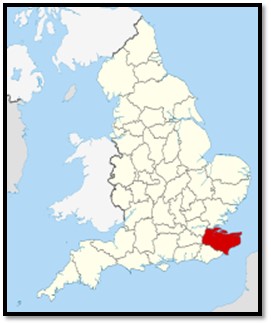
England showing Kent in red.
What were these places like in the 1700 and 1800’s and how did our ancestors live?
The Township of Sevenoaks
The origins of the township date to prior to 1456 when Thomas Bouchier, Archbishop of Canterbury, purchased the Knole estate and built the Knole house. Knole House remains to this day one of the major homes and parks in the Sevenoaks’ region, today under the care of The National Trust.Thomas Cranmer (1489-1556) was the last Archbishop of Canterbury, appointed by Henry VIII in 1533 and he owned Knole and Oxford Palace, both of which he was forced to hand over to the King ‘voluntarily’ in 1538. Cranmer played a leading role in the moves to break the Church of England from the Roman church as part of the King’s moves to divorce his first wife, Catherine of Aragon.
The main thoroughfares in Sevenoaks were (and still are) London Road and High Street.
Population
The first official national census of population was taken in 1801 when 2,640 people were recorded in Sevenoaks. The census returns were conducted every ten years, however, the census schedules for the years 1801 to 1831 were destroyed. By 1840, the population had almost doubled to 5,061.
Industry
The major industry until the 19th century was agriculture. Most other manufacturing industries were small-scale and related to local agricultural production, for example, milling corn and animal feeds, brewing, tanning, shoe making, tailoring and woollen cloth working. People, like our Launders, engaged in the building trades, wood and iron work and also the quarrying of stone and building materials. Market gardening was also one of the small-scale industries in the 19th century.
Facilities
Fuel - wood was the basic fuel throughout most of Sevenoaks, used for cooking and heating. Coal was another form of fuel used for domestic purposes coming from Gravesend and also Tonbridge.
Fire Brigade – the Sevenoaks Fire Engine Association with a horse-drawn fire engine was formed in 1830, funded by local residents and manned by volunteers.
Drainage – prior to 1880, Sevenoaks lacked a main drainage system to remove wastes. Privies and soil pits had to be regularly cleaned and wastewater lay on the surface resulting in smells and disease.
Markets – these have existed in Sevenoaks since the origins of the township. By the late 1700’s the Shambles area was where the butchers and fishmongers traded.
Mail – prior to 1837 various methods were used for delivery of mail. In 1837, the Sevenoaks Post Office was given a monopoly on mail delivery for the region. The penny post was introduced with the famous ‘penny black’ stamp of 1840, thus reducing the cost of postage to anywhere in the UK. The original post office established in 1840 was located at 58 High Street.
Transport
Bus services consisted of a horse-drawn omnibus which left the Dorset Arms Inn for London at 9 o’clock each morning (Sundays excepted) during the 1840’s. The journey took three hours and fares were 3 shillings for ‘outside’ and six shillings for ‘inside’. Farmers’ carts also provided a commercial service for carrying local goods.
The Poor
Low and irregular wages, sickness, widowhood, old age and misfortune meant that a large part of England’s population in the past lived in relative poverty. The growing number of poor vagrants was seen as a threat to social order and in 1572 an Act provided for the punishment of beggars coupled with relief for some of the poor. About one third of the population lived at subsistence levels and with the advent of increased mechanisation of farming methods (thus fewer agricultural work opportunities), poor harvests, and population growth, this meant an even greater increase in the numbers of poor.
This led to general unrest, and on Saturday night, August 28 in 1830, a widespread uprising by rural workers began in East Kent with the destruction of threshing machines and within a month over one hundred machines had been destroyed. This uprising became known as the “Swing Riots” which spread across southern England.
This general unrest and also agitation about the state of the workhouses led to the abolishment of the old poor law system and the introduction of the Poor Law Amendment Act 1834.
The “New Poor Law” as it became known attempted to curb the cost of poor relief and address abuses of the old system by allowing relief to be given only in workhouses and making conditions in workhouses such to deter any but the truly destitute from applying for relief.
In Sevenoaks, this gave rise to the Sevenoaks Union Workhouse. Able-bodied paupers would be put to work, children were put into apprenticeships and the aged and sick given support in their own homes, an almshouse, or the local workhouse.
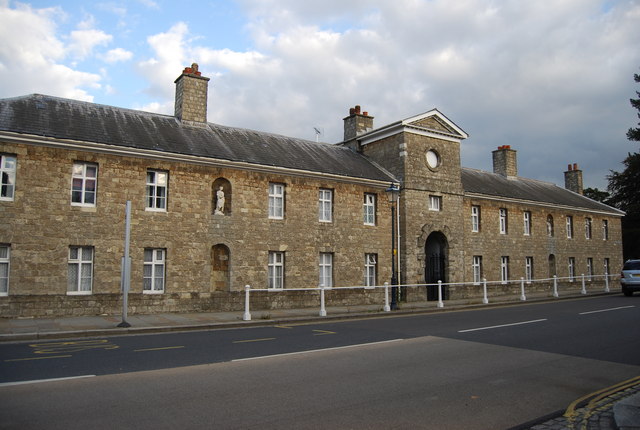
Sevenoaks’ Almshouse.
George’s parents, Thomas and Sarah Launder lived their last few years in the Sevenoaks’ Almshouse. Thomas was listed in the 1851 Census as Almsperson Sub Bailiff of County Court and Sarah as Almsperson, residing at the Almshouse in Sevenoaks. (Note – Bailiffs were appointed by the County Court and were concerned with executing the orders of the courts, generally around the collection of debts. A Sub Bailiff had fewer powers and worked in support of the Bailiff.
Living Standards
Regular outbreaks of epidemic and pandemic disease were a common cause of death until the late 19th century. Over half of Sevenoaks’ population died during the Black Death of 1347-49. In the 1600’s the water supply was poor and there was a failure to remove human and animal waste. Many houses were poorly built and were damp, cramped, smelly and overcrowded. Rats and other vermin were common. The cause of diseases was often unknown and there were no cures for influenza, ague (malaria), measles, cholera, smallpox and the plague. Plague again hit Sevenoaks in 1665-66 as shown by the increase in burials in those years. When cholera visited in 1854, one of the few actions available was to isolate people in the pest houses. Typhus and diarrhoea were also killers in the town in the mid 1800’s.
Education and Religion
The church bells of St. Nicholas parish church were familiar sounds. They were rung to call people to church services and also as a means of expressing loyalty, for instance, when Queen Elizabeth visited Knole in 1573.
Formal education was available to few children before the mid-19th century. Sunday schools provided some with basic knowledge of reading and writing. There were a few other schools which sprang up and then disappeared during this period, some being established by large employers for the children of their workers. It not known where or by what means George William Launder received his education, but what is certain is that he at least received a good basic education.
Sports
Although cricket clubs did not exist in the early 18th century, cricket was nevertheless played, often for a wager between different parishes with teams made up from those men employed by the gentry. The Sevenoaks Vine Club was formed in the late 18th century and George William Launder almost certainly took part in these cricket matches, to which a newspaper article, addressed further into this story, will attest.
George’s Ancestors
After many years of research, I have traced George William Launder’s family back to his great-grandfather, William Launder, and his wife Hannah – who were my great-great-great-great-great-grandparents! Their story can be found on another webpage. George’s grandfather was William Launder and grandmother was Hannah Golley. His parents were Thomas Launder and Sarah Puttoo – an odd name one might think, but there were many people with the surname Puttoo in Kent in that time. This is a simplified outline of George’s ancestry –Family Hierarchy
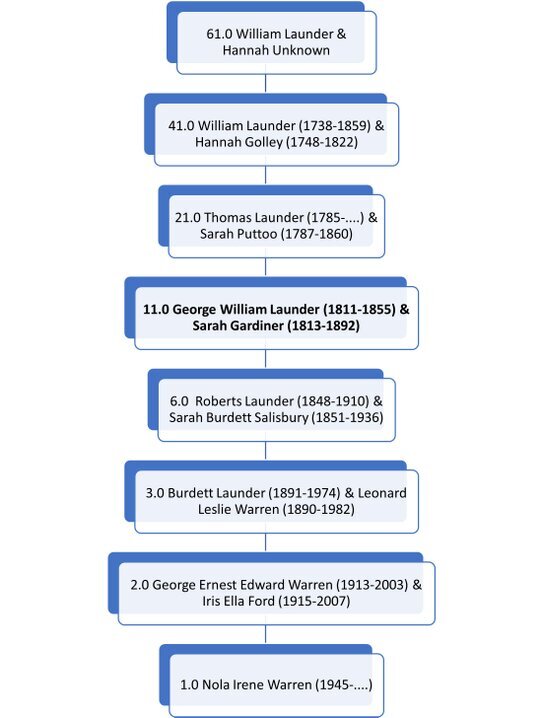
George Launder – His Early Life
1811 – Birth
George William Launder was born in Sevenoaks, Kent, UK on March 9 in 1811. He was christened a month later on June 5 at Sevenoaks and his parents were listed as Thomas and Sarah Launder.
Name: George William LaunderGender: MaleBaptism Date: 5 Jun 1811Baptism Place: Sevenoaks, Kent, EnglandFather: Thomas LaunderMother: SarahFHL Film Number: 1473692Ancestry.com. England, Select Births and Christenings, 1538-1975
Early records of Sevenoaks such as the Land Tax Assessment at Greenwich 1780 list the Launders living in Churchfields in Kent as well as William Roberts (Sarah’s father). The Pigot’s Directory of 1840 lists Thomas Launder (George’s father) as a wood turner, living in High Street and William Roberts (Sarah’s father) a “gent” also in High Street. A trade directory lists Mr. William Roberts of Sevenoaks under the heading ‘Nobility, Gentry and Clergy’ whilst George Launder, also of Sevenoaks is listed under Furniture Brokers. George’s father, Thomas is listed as a shovel maker under the heading of Turners – Wood. At another time, George is also listed as a ‘brewer’.
Little else is known of George’s early life, except we can deduct from later documents that he received a good education. Also, that he almost certainly played cricket at the cricket ground at Sevenoaks, known as the Vine Cricket Ground. It is one of the oldest cricket venues in England, given to the town of Sevenoaks in 1773 by the 3rd Duke of Dorset who was owner of the nearby Knole House.
As his father was employed as a wood turner, George may have been apprenticed to his father as George’s later occupations were mainly related to either furniture or later house building. George probably enjoyed a better standard of life than that of the average agricultural labourer – his paternal grandparents, William and Hannah Launder were relatively well-off, being able to employ a house maid - this information from an apprenticeship agreement dated 1806 for Mary Sharp to work for William and Hannah Launder.
George William Launder & Sarah Gardiner’s Story of their Life Together
1834 - Marriage
George and Sarah were both born and lived in Sevenoaks, Kent but married many miles away in Surrey at St. Mary’s Church, Newington on January 29 in 1834. George was 23 years old and Sarah 21. Other members of the Launder family were later to marry at this church so perhaps it held some relevance to the family.
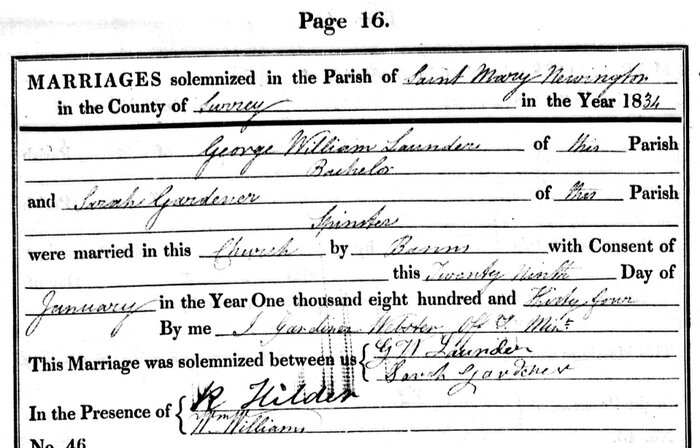
Both George and Sarah signed the register with well-formed signatures. One of the witnesses to the marriage was ‘R. Hilder’ and the other was William Williams. The Hilder person was most likely a relation of George’s mother, Sarah Puttoo as there were many marriages between Hilders and Puttoos in Sevenoaks around this time. After their marriage, George and Sarah returned to Sevenoaks where they set up their home together. They lived in London Road, Sevenoaks
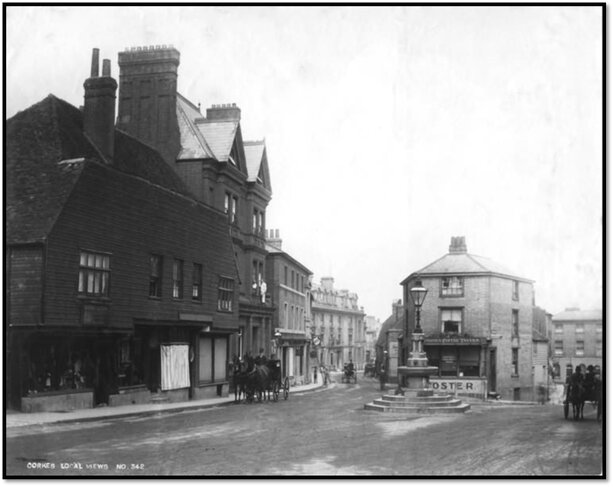
. The photograph, taken in 1890, some fifty years after they lived there shows the intersection of High Street and London Road, probably fairly unchanged from when George and Sarah, and indeed George’s father were there.
1834 – Birth of Daughter, Eleanor Ann Launder
George and Sarah settled down in Sevenoaks where George worked in the furniture trade. Then on August 26 of 1834 their first child was born, christened Eleanor Ann Launder on September 24 of that year. It does not appear that Eleanor’s birth was registered – at least I have never been able to locate the record, but she was baptised. Was their first child premature or had Sarah been pregnant at their marriage in January of 1834?
Name: Eleanor Ann LaunderGender: FemaleBaptism Date: 24 Sep 1834Baptism Place: Sevenoaks, Kent, EnglandFather: George LaunderMother: SarahAncestry.com. England, Select Births and Christenings, 1538-1975
1836 – Birth of Son, William John Launder
Eleanor Ann was followed by a brother named William John Launder, born in Sevenoaks on May 24, 1836. Baby William was baptised on June 26 in 1836.
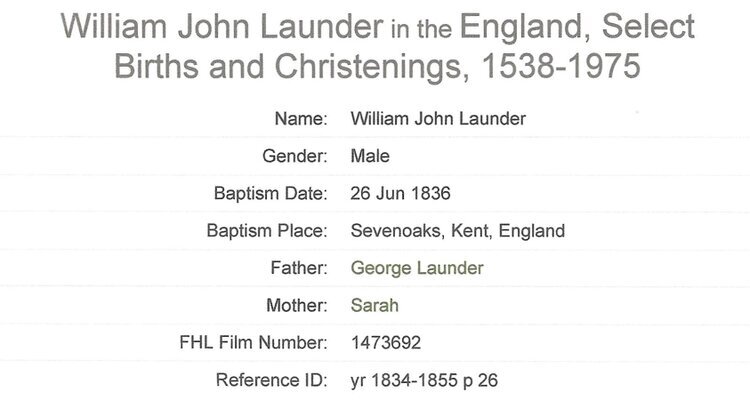
1838 – Birth of Son, George Launder
As regular as clockwork, every two years, another little Launder. This time, on July 5, 1838, a son named George born in Sevenoaks. Mother is Sarah Launder, formerly Gardiner. Father was George William Launder, Upholstered & Turner.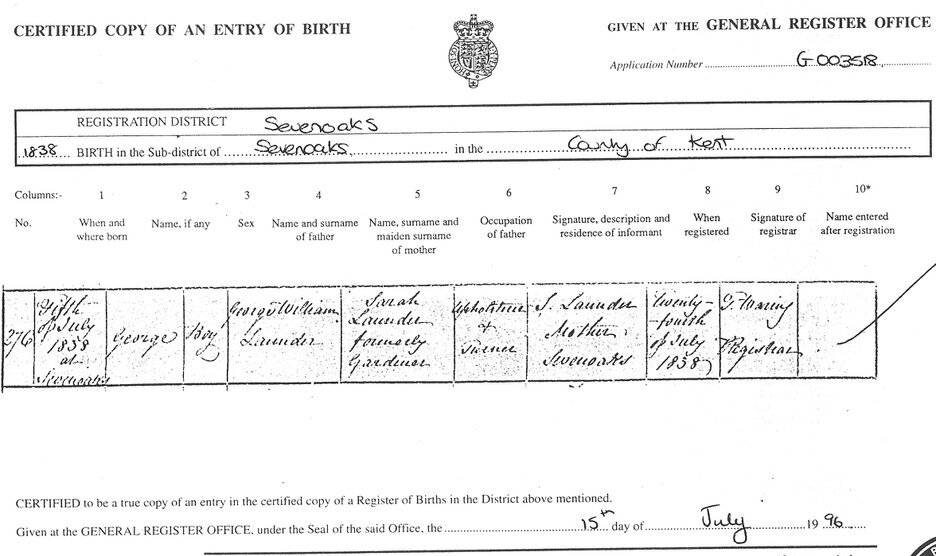
Baby George was baptised at the parish church of Sevenoaks on August 19 in 1838, this time George’s occupation is given as ‘Broker’ – perhaps finding that buying and selling of furniture more lucrative than making it?

Their fourth child, another daughter, Sarah Launder, was born on June 15, 1840 in Sevenoaks. The copy of the birth certificate is not suitable to photocopy, so a transcription is shown here. Baby Sarah was baptised in the parish church in Sevenoaks on July 11, 1840.
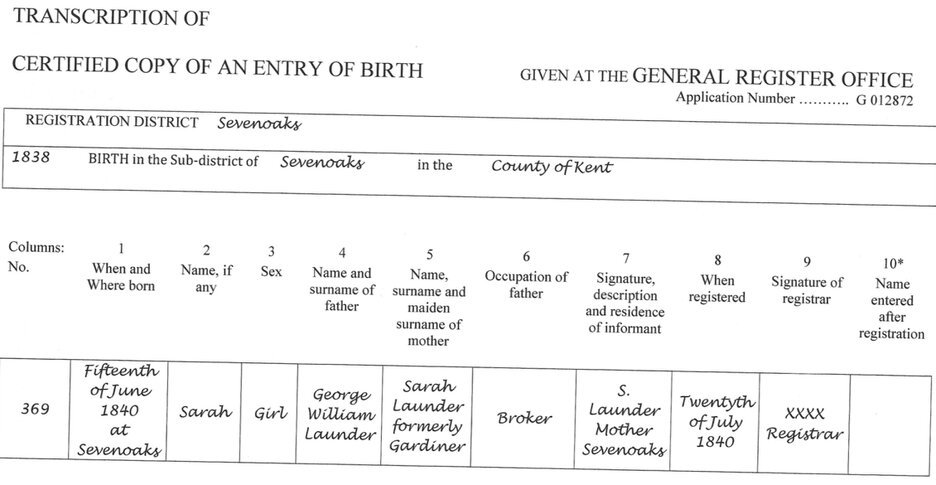
1841 - England and Wales Census
The year of the census saw George and Sarah with four children living in London Road, Sevenoaks. George gave his occupation as upholsterer. It is likely the young girl named Harriet Maker was a helper to Sarah and that the Fowler family members were boarders.
Name: George LaunderEvent Type: CensusEvent Date: 1841Event Place: Sevenoaks, Kent, England, United KingdomEvent Place (Original): Sevenoaks, Kent, EnglandCounty: KentParish: SevenoaksResidence Note: London RoadSex: MaleAge: 30Birth Year (Estimated): 1807-1811Birthplace: KentHousehold Sex Age BirthplaceGeorge Launder Male 30 KentSarah Launder Female 25 KentEleanor Launder Female 7 KentWilliam Launder Male 5 KentGeorge Launder Male 3 KentSarah Launder Female 1 KentHarriet Maker Female 15 KentFrederick Fowler Male 30 KentSusan Fowler Female 30 KentMary Fowler Female 1 Kent
1842 – Birth of Son, Thomas Howard Launder
The year after the census, another Launder baby arrived – Thomas Howard Launder – George and Sarah’s fifth child. Baby Thomas was baptized on October 16 of that year, but this time, George and Sarah gave their usual place of abode as Holborn in London and George’s occupation was listed as ‘brewer’.
Name: Thomas LaunderGender: MaleBaptism Date: 16 Oct 1842Baptism Place: Sevenoaks, Kent, EnglandFather: George LaunderMother: SarahAncestry.com. England, Select Births and Christenings, 1538-1975
1844 – Birth of Daughter, Amy Launder
Another daughter, Amy, was born in 1844 on September 15 at Sevenoaks. Perhaps George’s stint in Holborn, London as brewer, was continuing, as Amy’s birth certificate shows George’s occupation as ‘brewer’, but the residence of Sarah as Sevenoaks. 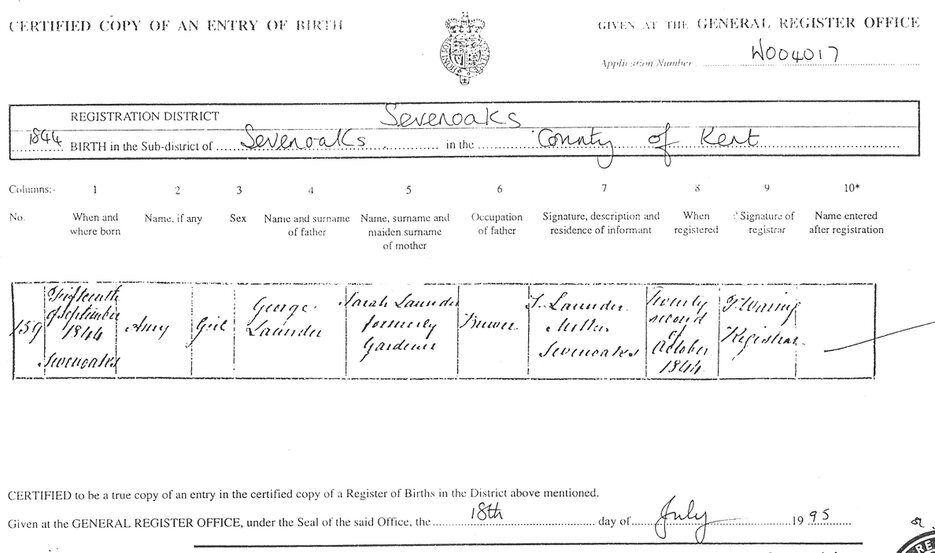
Baby Amy was baptized in Sevenoaks on December 15 of that year.

1846 – Birth of Daughter, Jane Launder
Like clock-work – every two years – another baby arrives. This time, another daughter, Jane Launder, George and Sarah’s seventh child, born in Sevenoaks.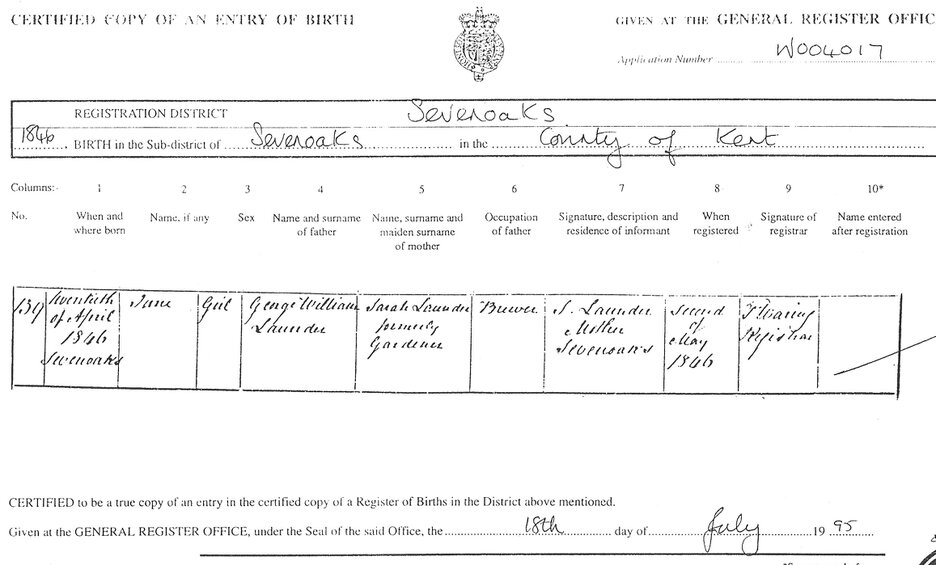
1848 – Death of Sarah’s Father, William Roberts
A substantial windfall for the family when Sarah’s biological father, William Roberts died in May of 1848. In his last will and testament, dated December 21, 1847, he acknowledged Sarah as his natural born child.
The original LW&T is hand-written and difficult to read. It is also lengthy. The transcription of the document is included at the end of this story, but for the purposes here, I will summarise that which is pertinent to George and Sarah.
- William Roberts acknowledged his “natural daughter Sarah now the wife of George Launder of Sevenoaks aforesaid Brewer formally Sarah Gardiner spinster.”
- He left Sarah a cottage and garden situated at Ide Hill. The cottage was occupied but was Sarah’s for her lifetime, after which, the property was to be shared between her children and their heirs “as tenants in common and not as joint tenants.”
- He left Sarah a third of ”all my share and stock in the long annuities now standing in my name in the Books of the Governor and Company of the Bank of England.”
- He left Sarah “my plate china linen and printed books ready money, money in the public stocks or funds and securities for money and all other of my personal estate and effect …….” …to “my natural daughter the wife of the said George Launder”
Here we have the explanation for the two surnames for Sarah - Sarah Gardiner was her birth mother and William Roberts her biological father - and Sarah's birth was listed as "base born", meaning her mother was not married at the time of the birth.
William Roberts was clearly a very wealthy man when he died and there were many beneficiaries to his will. Sarah certainly benefited greatly and perhaps her inheritance helped George and Sarah in their decision to make a new start in a new country.
Name: William RobertsGender: MaleDeath Age: 82Record Type: BurialBirth Year: 1766Burial Date: 11 May 1848Burial Place: Sevenoaks, KentKent Archives Office; Maidstone, Kent, England; England, Kent, Parish Registers, 1538-1911
1848 – Birth of Son Roberts Launder
On June 11 in 1848, just a month after Sarah’s father’s death, George and Sarah’s eighth child arrived. They named the baby Roberts, presumably in honour of Sarah’s biological father. My great-grandfather was born! William Roberts’ Will was proved on July 18, 1848 making Sarah a wealthy woman.
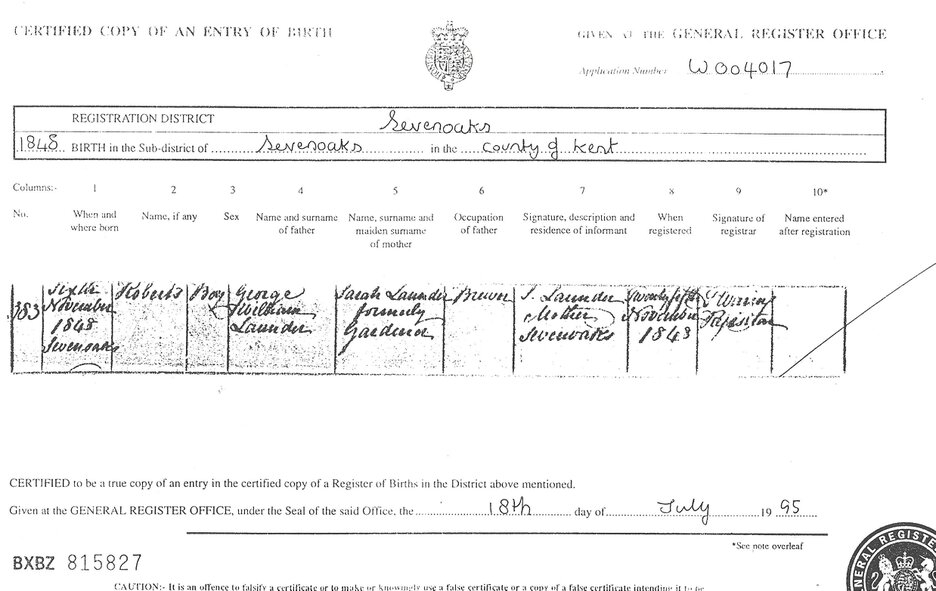
1849 – George Launder Leaves UK
Having made the momentous decision to emigrate to Australia, George left Sarah and the children in Sevenoaks while he sailed away on the barque “Senator”, arriving in Adelaide on October 27 in 1849. After a short look around Adelaide, George then turned his attention towards Victoria. He again boarded the barque ‘Senator” on November 13 bound for Melbourne. On the ship’s manifest, his name is listed as Robert Launder, but I have assumed this is our George Launder.
Once in Melbourne, George chose to live in the city of Melbourne whilst he determined the best place to settle his family and then pave the way for them to follow him. He clearly found friends from his old country to help him in his search and to share and enjoy his days with.
As an indication of George’s extrovert and friendly personality, having only been in Melbourne for a few weeks, he joined forces with several other men to organise a cricket match. The following newspaper article published in 1900 remembered the cricket match of 50 years earlier of which George Launder was an organiser and player.
Old Time Cricket Match.Fifty years ago, on Christmas Eve 1849, (writes "Mid On" in the Melbourne "Leader"), two new chum men of Kent and two Surrey men, the former, Messrs Launder and Holding, the latter, Messrs Baker and Coleman, met in a small brick shop (lately pulled down) in Little Bourke Street between Stephen and Russell Streets, to arrange a single cricket match between representatives of the above, then two celebrated cricketing counties.The match, which was for a 'leg of mutton and trimmings," duly came off on Boxing day, 1849, on the old Melbourne Cricket Ground, situated on the south side of the Yarra where the Castlemaine Brewery now stands.Although the pitch was in very fair condition, the outfield still bore traces of the late John Pascoe Fawkner's plough, as it was on this site that famous pioneer sowed his first crop of wheat. The great November flood of 1849. had left a large amount of dry mud on the surface, and had in a measure filled up the furrow marks but what would our present-day cricketers think of being asked to play upon such a pitch?Surrey won the toss and decided to bat, the two wickets falling for 6 runs. Kent managed to put together the respectable total of 21, and Surrey's second innings, totalled 13, Kent thus winning by an innings and 2 runs.The players adjourned to the Commercial Hotel, Little Bourke Street, kept by Hostess Wren, and a very enjoyable evening was spent by them, and the umpire and some friends.On that occasion the idea of bringing out an English eleven was probably first discussed, a suggestion being thrown out that in consequence of the distance, Australia and England might meet "at the Cape! " Of course, the thing was not feasible, but 12 years afterwards Stephenson's first English team arrived by the steamer Great Britain. Tom Sewell, who came with Stephenson was a member of the Sevenoaks Kent Club, and had often played with the two Kent players above mentioned. One of the latter, Mr. George Launder, has survived the half century intervening between that old-time, inter-county match and to-day and rarely misses an inter colonial or international contest in Melbourne.I hope to see him hearty and well at the inter colonial this year as usual.Kalgoorlie Western Argus (WA : 1896 - 1916), Thursday 18 January 1900
It should be noted that the newspaper reporter was incorrect in one significant fact. The George Launder that he mentioned in his penultimate paragraph was not the George Launder who is the focus of this story, but the son of our ancestor of the same name, our ancestor having died in 1855 – but more of that shortly.
At last, it seems Sarah received word from George instructing her to pack up the children and set sail for Australia. Sarah had real estate and possibly investments to sort out before she could leave Kent, but eventually, she boarded the sailing ship ‘Pestonjee Bomanjee’ with her brood of eight children – Eleanor Ann, aged 17, William, aged 15, George, aged 13, Sarah, aged 11, Thomas, aged 9, Amy aged 7, Jane, age 5 and Roberts, aged just 2.
It must have a good journey for Sarah, the children, and the other passengers, because many of them, including Sarah Launder, signed a letter addressed to their captain, Captain Edward Pavey –
At Sea, on Board the Ship Pestonjee Bomanjee, 37⁰ Lat S : 127⁰ February 15th, 1851 –SIR – We, the undersigned passengers in the above ship from England to Australia, being now on the point of arriving at our destination, beg leave to tender you our grateful acknowledgements for the manner in which you have discharged the duties of your station, by a strict attention to our comfort and safety.“South Australian Register” newspaper, Wednesday, February 19, 1851
Sarah Launder signed this note as one of the Intermediate Passengers. After a brief stop-over in Adelaide, South Australia, the ship arrived into Melbourne on February 18, 1851, shortly afterwards heading out to her new home in the fledgling village of Hawthorn.
Early Hawthorn
Today, the suburb of Hawthorn is regarded as a ‘select’ address predominated by grand houses. The humble cottages of the past have been razed, and the old brick houses reinvented by enthusiastic renovators to bring them into line with Hawthorn’s current up-market status.
However, Hawthorn’s beginnings were far from ‘high end’. The original inhabitants of the land were members of five aboriginal tribes which together formed the Kulin nation. Their first glimpse of the European occupants came in about 1830. A few years later in 1837, John Gardiner (after whom Gardiner’s Creek is named) and his family came to the area and set up house, but they only stayed a short time before returning to town life, finding the privations too difficult to bear. Gardiner eventually sailed for England in 1841, taking with him news of the new land. Was John Gardiner a relation of our Sarah? Is that why George and Sarah decided to settle in Hawthorn? Or just a co-incidence they shared the same surname?
The picture below shows a typical slab and shingle hut in which the earliest pioneers of Hawthorn set up house. It is not supposed that George and Sarah were reduced to this level of hard living by the time they arrived in Hawthorn in 1851. But, nevertheless, their early days, months and indeed years, would have been tough.
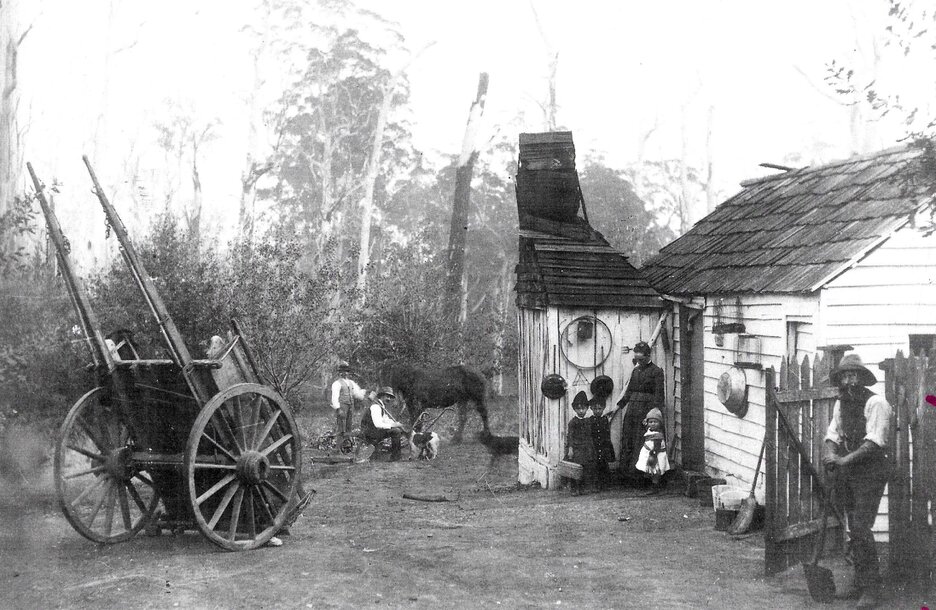
Early Pioneer Accommodation in Hawthorn (Latrobe Collection, Hawthorn Library)
In 1837 the area was surveyed and described as having ‘fine undulating grass rises’ with good timber and drinking water. Further surveys in 1841 resulted in land being released as ‘unsurveyed land’ which could be purchased at £1 per acre payable to the British Government.
Land in other newly established suburbs such as Malvern and Richmond across the river from Hawthorn was snapped up but the Boroondara land (Hawthorn) was neglected at this stage. A depression in the 1840’s probably accounted for this slowdown, as well as the flooding of the Yarra River at this time. However, as the effects of the depression eased and land speculation increased, Hawthorn was once again in the focus.
By the mid-1850’s following the discovery of gold in Victoria, more land in Hawthorn was subdivided and sold by the Crown. Land had been set aside for churches and a school and small half-acre blocks were being sold which formed the original little village called ‘Hawthorn.’ There were scattered commercial enterprises, including forges, saddlers, hotels, stables, and stores to serve the passing traffic as well as the local growing population.
One of the first property owners who subdivided his land was John Collings who will figure later in George and Sarah Launder’s story. In 1851, John Collings purchased land and subsequently built ‘Auburn House’ at 4 Goodall Street, before subdividing the block and selling the house to Robert Hepburn.
Not long after the arrival of George Launder and his family, the Port Phillip Settlers Association successfully lobbied to have Victoria recognised as a separate colony from New South Wales. La Trobe became its first Lieutenant-Governor in July 1851.
In 1851, the white population of the whole of Port Phillip District (Victoria) was still only 77,000 although it had already become a centre of Australia’s wool export trade. Only 23,000 people lived in Melbourne. Until the building boom which followed the gold rushes of the 1860’s, most of Melbourne was built of timber and almost nothing from this period survives, except two examples. One is the St. James Old Cathedral, built in 1839 in Collins Street and now relocated to the Flagstaff Gardens. The second is St. Francis Catholic Church built in 1841 in Elizabeth Street.
The Rev. Liddiard was also one of the early purchasers who bought land in 1852 at cheap prices and subdivided to make a quick profit. Liddiard’s land-sale generated the growth of a new commercial and residential centre known as Upper Hawthorn.
By 1851, George was listed as a cabinet marker in the directory “Port Phillip Victoria 1851” and his business address was 27 Lonsdale Street West, Melbourne.
1852 – Birth of Son, Harold James Launder
Life for George and his family must have been so hectic at this time that when their ninth child was born, they may have forgotten to register the birth, as in spite of intensive searching, no record has been found of the birth of their son, Harold James Launder in Hawthorn in 1852. We know of his existence and birth year from other secondary sources.
1852 - Life in Hawthorn
George Launder, describing himself as a farmer, purchased 2 blocks of land from Rev. Liddiard in September and October,1852 for which he paid £1,230. The larger block of 10 acres was situated between Oxley Road and Burwood Road, near to where the Hawthorn Town Hall now stands George’s land was situated on Burwood Road – on the south-east corner of Glenferrie and Burwood Roads, Hawthorn. His land became known as “Launder’s Paddock”. Population of Hawthorn numbered about 327 by 1854.
George’s land, “Launder’s Paddock”, was situated between the present-day Kent Street and Columbus Street and was first used as a large market garden and greengrocery run by Bellett and Cottingham, then about six cottages, probably built by George Launder, were erected, and rented out to tenants. Some of the occupants included a newsagent, a plumber, butcher, and a carter – all practicing their trade from their houses. At this time, it was quite common for goods to be displayed in the street for selection by customers, including fresh meat, whilst the tradesperson lived in the house behind.
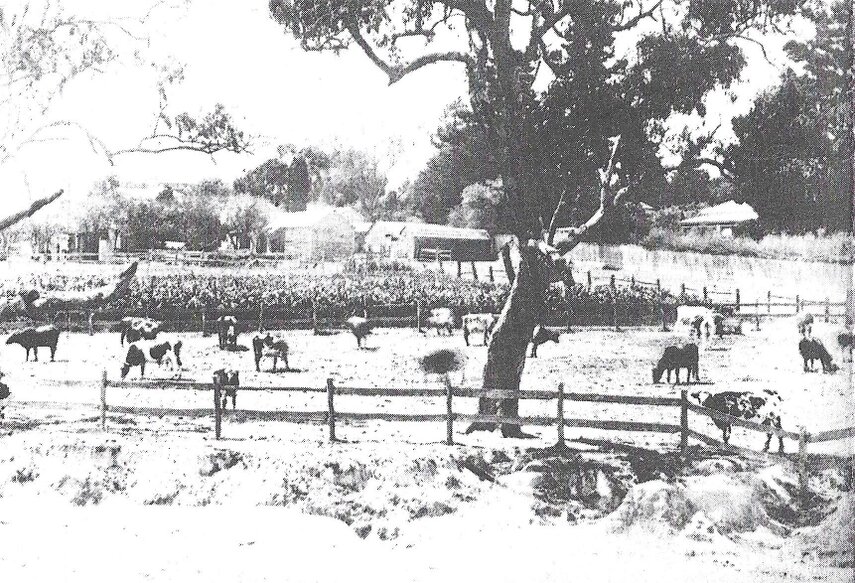
Launder’s Paddock looking back towards St. Columb’s Church, about 1870 (St.Columb’s Hawthorn 1883-1983, Jane Carolan)
An interesting excerpt from “Hawthorn Peppercorns” by Gwen McWilliam reads –
The narrowness of Oxley Road was not really due to the subdivider …. in this case, probably John Collings, who allowed for a road to reach the large properties in his subdivision of Crown portion 64 from about 1854. There was a complaint that because George Launder (who lived on the north side) would not double the width of Oxley Road, Robert Hepburn refused to dedicate land to become a Public Highway at all. And so, Oxley Road stayed narrow until his property at the east end was subdivided when a new wide Oxley Road provided access to the new roads there!
1853 – Birth of Daughter, Mary Ann Launder
George and Sarah’s tenth child arrived on August 25 in 1853 in Hawthorn and they named her Mary Ann Launder.Name: Mary Ann LaunderBirth Date: Abt 1854Birth Place: Hawthorn, VictoriaRegistration Year: 1854Registration Place: Victoria, AustraliaFather: George LaunderMother: Sarah GardinerAncestry.com. Australia, Birth Index, 1788-1922
The Birth Index indicates an approximate birth date, but 32 years later, Mary Ann Launder decided to have herself baptised, and confirmed her correct birth date and year.
1854 – Land Sale
In 1854, George sold part of his land, fronting Burwood Road to George Fletcher who built a hotel on the land – it was known as ‘Fletcher’s Iron Hotel’. Fletcher's Hotel was probably the first building actually built on the crossroads, the forerunner of Glenferrie shopping centre. The hotel was a two-storey iron building.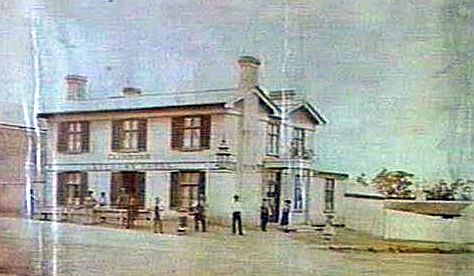
Fletcher’s Iron Hotel, Hawthorn, Circa 1861 (Latrobe Collection, State Library of Victoria)
1855 – Licensee of Fletcher’s Iron Hotel, Hawthorn
On April 7, 1855, George Launder was granted a publican’s licence of the Fletcher’s Hotel in Hawthorn. At the same Licencing Meeting, George Fletcher’s application was withdrawn. (“The Age” newspaper of that date)
The 1850’s in Hawthorn was a busy, booming time – gold had been discovered in Victoria and Hawthorn was on the route for through traffic to the gold fields. Most of the traffic through the town – timber drays, bullock teams, stock, and people – still converged on Burwood Road on the way to the river crossing – the original punt having by this time been replaced by a bridge.
Rarely are women captured in the history books of that time, but our Sarah Launder, with her spirit and business acumen, managed to do just that. She was recorded in the rate books as owning tents which she rented out to passing traffic on the land fronting Burwood Road.
The area where George Launder owned land became known as Upper Hawthorn – the residents wanting to distinguish themselves from the original Hawthorn pioneer settlement. The road to the Glen Ferry, south of Gardiner’s Creek, became known as Glenferrie Road.
During this time, George worked as a builder, taking advantage of the boom times. He built and sold many of Hawthorn’s early homes which were built most likely of weather boards, rather than solid brick. Later comments about Hawthorn’s history refer to the ‘shoddy clapboard houses’ thrown up by greedy builders in Hawthorn’s early days. Whether this was true of George or not, cannot be proven, but searching has failed to find any houses still standing today which were built by George Launder. Nevertheless, he provided the residences which were in demand at that time. Later when gas was available in the area, gas was said to be responsible for the disappearance of most of the wooden cottages along Burwood Road – obviously, fire hazards.
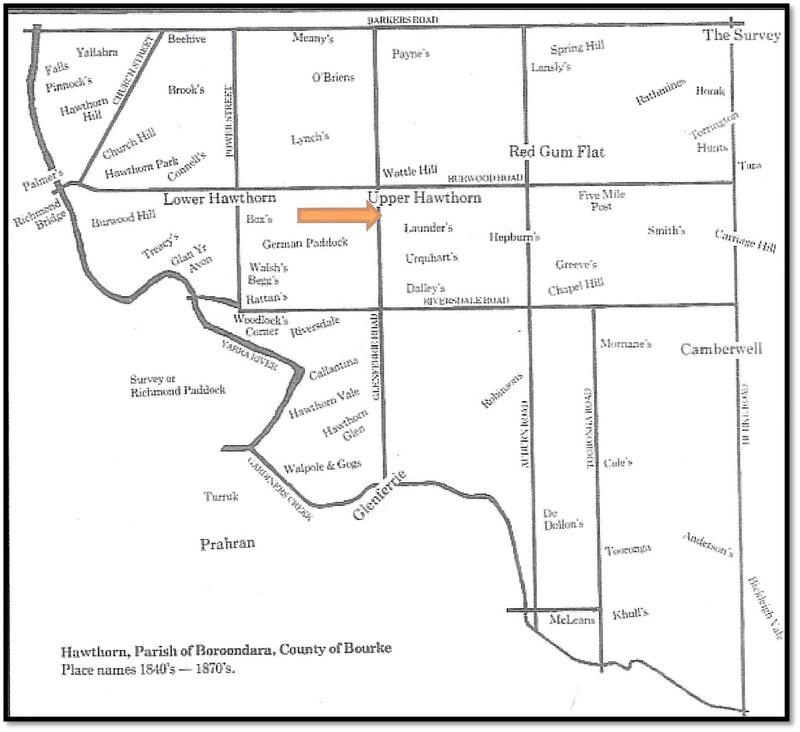
The map shows place names and street names in Hawthorn during the 1840’s to 1870’s. Launder’s allotment is indicated by the arrow.
So far during the first four years George and Sarah had lived in their new land, all went very well for the family. They had ten children, all living – in itself a remarkable feat in a period of high infant mortality. The children ranged in age from 21 years to the youngest, just 2 years old, by 1855. And Sarah was pregnant with her eleventh child. George had invested well in land and buildings and was a licensee of one of the four main hotels in Hawthorn at the time.
1855 – Death of George Launder
But, on June 20 in 18555, George Launder, described as Hotel keeper, aged 44 years, died from an abscess of the left lung, the effect of which he had been suffering for several days prior to his death. Perhaps this was lung cancer? He died at home in Upper Hawthorn with a friend, Thomas Baker a Cabinetmaker, also of Upper Hawthorn, with him at the end and who was also the informant who registered George’s death. George’s father was given as John Launder, a Turner, and his mother as Sarah Launder. George had been in Australia for just five years and six months.
It should be noted that death certificates provide the least reliable information for genealogy researchers as it is often provided in haste, under stress and in George Launder’s case, by a friend, rather than a knowledgeable relative. George’s father’s name was actually Thomas Launder, but yes, he was a Turner and yes, his mother’s name was Sarah. Information contained on George’s death certificate –
Deaths in the District of Boroondara in the Colony of Victoria
When and where died June the Twentieth 1855, Upper Hawthorn
Name and Occupation George Launder, Hotel Keeper
Sex, Age Male, 44
Cause of Death Abscess of the left lung
Duration of Illness 14 days
Medical Attendant by whom Certified Wm. Farrage
When last saw Deceased June 20, 1855
Name and Surname of Mother & Father John Turner, Sarah Launder
Rank or Profession Turner
Signature, Description & Residence of Informant John Baker, Cabinet Maker, Upper Hawthorn, Present during last illness
Date and Where Registered June 22, 1855, Hawthorn
When and Where Buried June 23, 1855, The New Cemetery
Witnesses to Burial William Stephens, Walter Dudley
Where Born & How Long in Australian Colonies Sevenoaks, Kent, 5 ½ years in Victoria
If Married, Where, Age and To Whom Sevenoaks, 22, Sarah ……..
Issue, in order of Birth, Their Names & Ages Ellen Launder, 20
William, 19
George, 17
Sarah, 15
Thomas, 13
Amy, 11
Jane, 9
Roberts, 6
Harry, 3
Mary Ann, 1
Clearly, those surrounding George Launder on that day in June were fearful for his life. And when it was discovered that he had not written any last testament, pen and paper were quickly found, a will written, and George, propped up with a pen placed between his fingers, was encouraged to record his signature.
George signed his last will and testament on June 20, 1855, just hours before his death. His will read –
I, George Launder this day bequeath to my wife Sarah Launder all my property and other effects now in my possession viz., Money, Lands, Houses, Horses and all other utensils belonging to me for her lifetime and at her death to be equally divided amongst my family.Signed George Launder Witnessed Wm. Farrage Wm. Stephens
This is a copy of his original will witnessed by his doctor, William Farrage and a friend, William Stephens -
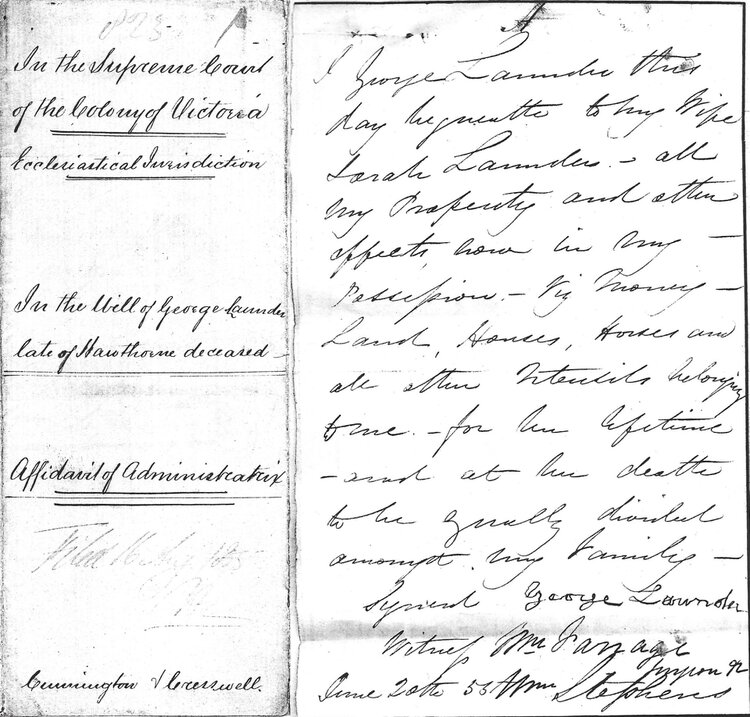
As part of the process of proving the will and issuing administration rights to Sarah, she was required to sign an Affidavit dated August 14, 1855 – this is a transcript -
In its Ecclesiastical Jurisdiction In the Will of George Launder late of Hawthorne near the City of Melbourne In The Colony of Victoria Gentleman deceasedI Sarah Launder of Hawthorne in the Colony of Victoria make oath and say -1. That the writing herewith annexed, marked A contains the true last will of George Launder late of Hawthorne in the Colony of Victoria deceased, as far as I know or believe.2. That the said George Launder left me the said Sarah Launder his lawful widow and Eleanor, William Charles, George, Sarah, Thomas, Amy, Jane, Roberts, Henry and Mary Ann children him surviving.3. That I will faithfully administer according to the tenor of the said Will all the property of the said George Launder so far as the same will extend and the law charge me.4. That I will exhibit a full and true inventory of the property of the said George Launder and an account of the administration thereof, as I may be required by the Rules of this Honorable Court.5. That I believe the property of the said George Launder does not exceed in value Two hundred pounds and that I the said Sarah Launder am as I believe lawfully entitled to the administration thereof.Sworn at Melbourne in the ]Colony of Victoria this fourteenth ]Day of August ] S LaunderIn the year of our Lord one thousand ]Eight hundred and fifty five ]Before me A Commissioner for taking Affidavits
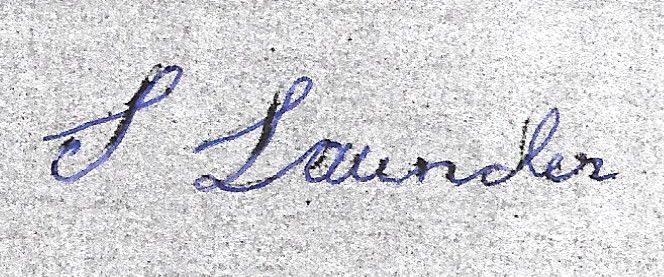
This is Sarah’s actual signature
1855 – George Launder’s Burial
George Launder was laid to rest on June 23 at The New Cemetery, Melbourne. His grave is located not far from the Burke & Wills Monument near the College Crescent in Carlton. There is an impressive headstone on the grave and the inscription reads –In Affectionate Remembrance of
GEORGE
The Beloved Husband of
SARAH
Late of Seven Oaks, Kent, England
Who Died at Hawthorn, 20 June, 1855
Aged 44 years
Also
SARAH, his wife
Who Died 3 November, 1892
Aged 79 years
Whoever shall call upon the name of the Lord shall be saved.
J. Hanson
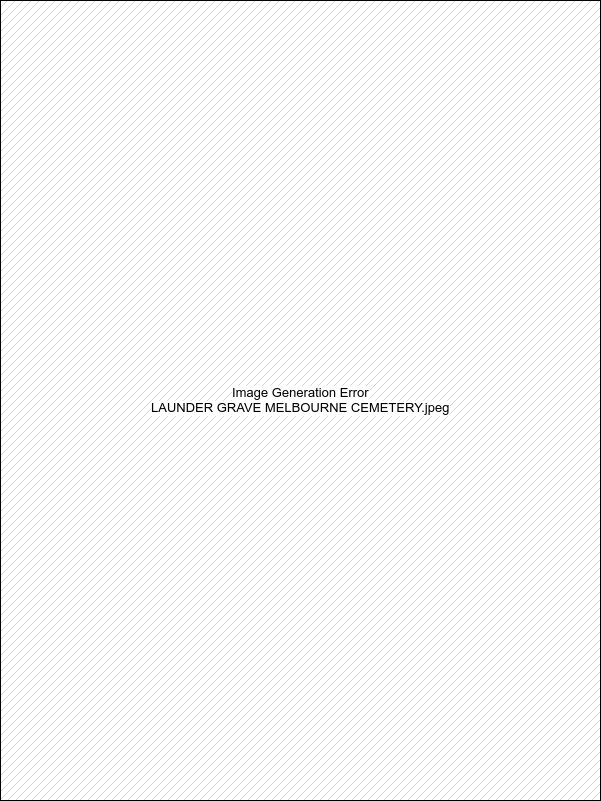
Administration of George’s estate was granted to Sarah, who estimated the value of his property was less than £200 – no doubt the valuation was a bit on the low side in order to avoid death duties.
Just thirteen days after George’s death, Sarah gave birth to her last child on July 3, 1855 – a little girl who was not even named before she died. Perhaps the baby’s arrival was brought on by shock and she was premature? The informant was Hannah Gray, nurse of Upper Hawthorn who signed the registration book with a cross. The accoucheur was Mr. J.D. Bragge. The birth registration was recorded on July 8, 1855. The child lived 3 days.
